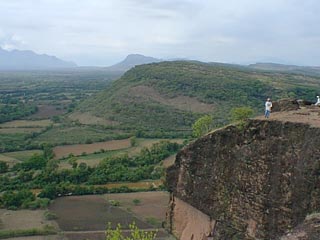
| FAMSI © 2001: Jay E. Silverstein |
||
A Study of the Late Postclassic Aztec-Tarascan Frontier in Northern Guerrero, México: The Oztuma-Cutzamala Project, 1998
Research Year: 1998 Table of Contents
Background The Oztuma-Cutzamala Project (POC) consisted of a field survey of 125 archaeological sites situated in the 1500 sq. km area between the Late Postclassic Aztec fortress of Oztuma, Guerrero, and the ethnohistorically known Tarascan garrison town of Cutzamala, Guerrero (Map 1). Colonial and Prehispanic documents indicate that, from about A.D. 1460 until A.D. 1521, the Aztec and Tarascan empires clashed along an extensive frontier defined by the modern states of Michoacán, México, and Guerrero (Durán, 1994; Stanislawski, 1947). In ca. 1479 the Aztecs, apparently in response to Tarascan advances towards the central highlands along the Balsas River, conquered the Chontal province (alteptl) of Oztuma and constructed a massive fortification manned by warriors and their families from the Aztec Imperial core (Relación Geográfica, 1985). Likewise, an account in the Relación Geográfica (1987) for Michoacán of 1580, reports that the town of Cutzamala held a garrison of 10,000 warriors whose objective was to carry the war to the Aztecs and capture their fortress at Oztuma. Thus the ethnohistoric documentation indicates that the frontier between Oztuma and Cutzamala was a highly militarized border in which intensive territorial warfare was an essential occupation for at least forty years. Implicit in the definition of empires is the coercive relationship between the imperial core and the peripheral provinces. While war on a frontier may require a commitment of troops and resources from the imperial core, it would have had a greater impact on the indigenous Cuitlateca and Chontal populations of the region who had been integrated into the larger geopolitical conflict. The reported intensity and scale of the Aztec-Tarascan conflict in Northern Guerrero suggests that the execution of this war should have made a significant impact on the material life of the Late Postclassic people of the region. Following this hypothesis, the POC was designed to explore the impact of the imperial conflict on the local populations and examine the imperial organization of the frontier. Click to download the report in PDF format: The PDF files require Adobe Acrobat Reader.
Submitted 09/01/1999 by: |
||
| Return to top of page | ||
|
Text links to all pages at this site are available at the FAMSI INDEX |
||

